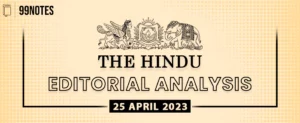29 April 2024 : The Hindu Editorial Notes PDF
The Hindu EDITORIAL
29-April-2024
1. Inequality can no longer be ignored
| Topic: GS2 – Social Justice, GS3 – Indian Economy – Inclusive growth
This topic is crucial for UPSC as it pertains to socioeconomic issues, governance, and policy-making in India’s development agenda. |
| Context: |
| ● The article discusses the growing debate on inequality and wealth redistribution in India, emphasizing the need for inclusive growth policies and increased welfare spending. |
Debate on Inequality and Wealth Redistribution
- The Congress party’s Nyay Patra manifesto has sparked a debate on inequality and wealth concentration, amplified by the Prime Minister’s comments.
- Rising inequality in India, evident from the World Inequality database, necessitates addressing the societal costs of unequal growth.
Welcome Election Issue
- The emergence of inequality as an election issue is crucial, highlighting the failure of trickle-down economics and the need for inclusive growth policies.
- Social media discussions largely focus on direct redistribution measures, given India’s low tax-GDP ratio and regressive taxation structure.
Low Welfare Spending
- Welfare spending in India remains low, particularly in sectors like health, education, and employment generation, hindering inclusive development.
- Despite targets set by policies like the National Health Policy, actual spending falls short, exacerbating inequality.
Questioning Growth Patterns
- The nature of growth in India, characterised by jobless growth and stagnant wages, necessitates a shift towards employment-centred development.
- Governments must prioritise job creation through filling vacancies, expanding public services, and improving job quality for better human development outcomes.
Role of Government in Job Creation
- Direct job creation efforts by the government, especially in sectors like health and education, can address unemployment and improve human development indicators.
- Employment-centred growth requires policies supporting small and medium enterprises, skill training, and women’s participation in the labour market.
Conclusion
- Addressing inequality requires a shift from profit-centric growth to employment-centred development, emphasising job creation and equitable access to services.
- Government policies must prioritise inclusive growth measures to reduce inequality and promote sustainable development.
| Growing inequality in India |
| Some important data:
● Top 10% of India’s populace owns 77% of national wealth; wealthiest 1% controls 53%. ● Income inequality: Top 10% and top 1% command 57% and 22% of national income, while bottom 50% share 13%. ● Tax burden: Bottom 50% contributes 64% of GST revenue, contrasting with 4% from top 10%. ● Healthcare accessibility: Healthcare costs plunge 63 million Indians into poverty yearly. ● Food security: 74% can’t afford healthy diets, 39% lack nutrient-adequate food. ● Hunger and malnutrition: India’s Global Hunger Index (GHI) score is 28.7, child-wasting rate highest at 18.7. ● Gender inequality: India ranks 127 out of 146 nations in Global Gender Gap Report 2023; workforce “missing women” persist as a challenge. (Source – The Hindu Newspaper – January 16, 2024) Reasons for Growing Inequality: ● Economic Policies: Economic reforms and liberalisation policies have led to unequal distribution of wealth, with benefits accruing to the affluent while marginalised groups remain excluded. ● Urban-Rural Divide: Disparities between urban and rural areas in terms of access to resources, infrastructure, and opportunities exacerbate income inequality. ● Education Disparities: Unequal access to quality education perpetuates socio-economic disparities, limiting opportunities for upward mobility. ● Informal Sector: The dominance of the informal sector in India’s economy leads to low wages, precarious employment, and lack of social security, contributing to income inequality. ● Caste and Social Discrimination: Persistent caste-based discrimination and social hierarchies perpetuate inequalities, particularly affecting marginalised communities. ● Gender Disparities: Gender-based discrimination in education, employment, and wages results in lower incomes and limited economic opportunities for women, exacerbating inequality. ● Wealth Concentration: Concentration of wealth among a small elite contributes to widening income gaps and exacerbates socio-economic inequality. Implications of Growing Inequality: ● Social Unrest: Rising inequality can fuel social tensions, conflicts, and unrest, leading to instability and discord within society. ● Health Disparities: Inequality in access to healthcare leads to disparities in health outcomes, with marginalised communities suffering from higher rates of morbidity and mortality. ● Education Divide: Inequality in education perpetuates intergenerational poverty and limits social mobility, widening the gap between the rich and the poor. ● Political Instability: Growing inequality undermines democratic principles and can lead to political instability, populism, and erosion of social cohesion. ● Economic Growth: High levels of inequality can hinder economic growth and development by limiting human capital formation, productivity, and innovation. Way Forward: ● Progressive Taxation: Implement progressive tax policies to redistribute wealth and income, ensuring a more equitable distribution of resources. ● Investment in Education: Increase investment in education, particularly for marginalised communities, to improve access to quality education and enhance skills development. ● Social Protection: Strengthen social safety nets, welfare programs, and labour rights to provide support and protection for vulnerable populations. ● Gender Equality: Promote gender equality through policies and programs that empower women, eliminate discrimination, and ensure equal opportunities in education and employment. ● Inclusive Economic Growth: Foster inclusive economic growth by prioritising sectors that create employment opportunities, promote entrepreneurship, and reduce poverty. ● Land Reforms: Implement land reforms to address land ownership disparities and ensure access to land for landless farmers and marginalised communities. |
| PYQ: COVID-19 pandemic accelerated class inequalities and poverty in India. Comment. (150 words/10m) (UPSC CSE (M) GS-1 2020) |
| Practice Question: Discuss the implications of rising inequality in India and evaluate the effectiveness of proposed measures for wealth redistribution and inclusive growth. (150 Words /10 marks) |
2. The RBI must assess the impact of climate change on economic stability
| Topic: GS3 – Indian Economy
This topic is vital for UPSC as it addresses the intersection of climate change, monetary policy, and sustainable finance. |
| Context: |
| ● The article highlights the Reserve Bank of India’s focus on climate risk in its Monetary Policy Report, emphasizing the potential economic impact of extreme weather events and the need for transition to a green economy. |
RBI’s Focus on Climate Risk in Monetary Policy Report
- The Reserve Bank of India (RBI) highlights the impact of “extreme weather events” and “climate shocks” on food inflation and the natural rate of interest in its latest Monetary Policy Report.
- It employs a “New-Keynesian model” to estimate the macroeconomic impact of climate change, predicting a potential 9% decrease in long-term economic output by 2050 without mitigation policies.
Implications of Climate Change on Monetary Policy
- Climate change poses challenges to maintaining economic output and controlling inflation, potentially leading to a de-anchoring of inflation expectations and undermining the central bank’s credibility.
- Higher interest rates may be necessary to curb inflation, resulting in greater output loss if inflation hysteresis becomes entrenched.
RBI’s Initiatives for Transition to a Green Economy
- Since July 2022, the RBI has incrementally addressed climate risk and sustainable finance, recognizing the need for India to mobilise over $17 trillion to achieve net-zero ambitions by 2070.
- Inspired by advanced economies like the European Central Bank, the RBI aims to develop a green taxonomy to assess the sustainability of economic activities and prioritise green financing.
Green Taxonomy and Sustainable Finance
- The RBI could learn from the ASEAN region’s approach to green taxonomy, which continuously updates sectoral views of sustainable trajectories, reflecting India’s fragmented developmental paths.
- Measures like issuing Sovereign Green Bonds worth ₹16,000 crore and allowing Foreign Institutional Investors to participate in future green government securities are commendable but require thorough assessment for their economic and financial stability impact.
Mitigating Transitional Risks
- The RBI must facilitate administrative consultation to develop a comprehensive green taxonomy aligned with India’s developmental goals, aiming to mitigate transitional risks to the financial system during the shift to sustainability.
- A layered green taxonomy can provide a framework for evaluating the sustainability of economic activities and guiding investment decisions towards a sustainable future.
| Impact of Climate Change on Economic Stability |
| Impact of Climate Change on Economic Stability:
● Decreased Agricultural Output: Climate change leads to reduced crop yields, affecting food security and rural incomes. ● Increased Insurance Costs: Extreme weather events raise insurance premiums and payouts, straining household and business finances. ● Disruption of Infrastructure: Damage to infrastructure from natural disasters disrupts economic activity and requires costly repairs. ● Healthcare Expenditures: Rising temperatures and air pollution increase healthcare costs due to heat-related illnesses and respiratory diseases. ● Loss of Livelihoods: Climate-induced displacement and migration lead to loss of livelihoods and strain resources in affected areas. Way Forward at Administrative Level: ● Develop a comprehensive green taxonomy to assess the sustainability of economic activities and guide green financing. ● Mobilise resources for transitioning to a green economy, aiming to achieve net-zero ambitions by 2070. ● Thoroughly assess the economic and financial stability impact of green initiatives like Sovereign Green Bonds and green government securities. ● Facilitate administrative consultation to develop a layered green taxonomy reflective of India’s developmental trajectories. ● Policy Integration: Integrate climate change considerations into economic planning and policy formulation at all levels of government. ● Risk Assessment: Conduct comprehensive risk assessments to identify vulnerable sectors and regions and prioritise adaptation measures. ● Investment in Resilience: Allocate resources for climate resilience measures, including infrastructure upgrades, early warning systems, and disaster preparedness. ● Capacity Building: Build administrative capacity to implement climate adaptation and mitigation strategies effectively. ● Stakeholder Engagement: Foster collaboration with stakeholders, including local communities, businesses, and NGOs, to develop and implement climate resilience plans. ● Monitoring and Evaluation: Establish monitoring mechanisms to track the effectiveness of climate policies and interventions and adjust strategies as needed. |
| PYQ:
Q.1 ‘Climate Change’ is a global problem. How will India be affected by climate change? How Himalayan and coastal states of India be affected by climate change? (250 words/15m) (UPSC CSE (M) GS-3 2017) Q.2 Discuss the consequences of climate change on the food security in tropical countries. (150 words/10m) (UPSC CSE (M) GS-1 2023) |
| Practice Question: Discuss the significance of integrating climate risk considerations into monetary policy and the challenges posed for financial stability. How can India transition to a green economy effectively? (250 Words /15 marks) |
For Enquiry

29 April 2024 : The Hindu Editorial Notes PDF

29 April 2024 : Indian Express Editorial Analysis

Sub Inspector Salary per month in India- Check other Perks & Allowance also

27 April 2024 : Daily Current Affairs Quiz

27 April 2024 : Daily Answer Writing

27 April 2024 : The Hindu Editorial Notes PDF

27 April 2024 : Daily Current Affairs

27 April 2024 : PIB Summary for UPSC

27 April 2024 : Indian Express Editorial Analysis

26 April 2024 : Daily Current Affairs Quiz
April 2024 The Hindu Editorial 29 April 2024 : The Hindu Editorial Notes PDF The Hindu EDITORIAL
29-April-2024
1. Inequality can no longer be ignored
Topic: GS2 – Social Justice,…
April 2024 Indian Express 29 April 2024 : Indian Express Editorial Analysis Indian Express Editorial Analysis
29-April-2024
1. FOR FUTURE READY SENIORS
Topic: GS2 – Social Justice…
Blogs Upsc Sub Inspector Salary per month in India- Check other Perks & Allowance also Sub Inspector Salary – The starting salary of a police sub-inspector in India can vary from state…
Daily Quiz 27 April 2024 : Daily Current Affairs Quiz 27- April 2024 : Daily Quiz…
mains answer writing 27 April 2024 : Daily Answer Writing Mains Answer Writing
27-April-2024
Q1) Describe the functioning of the Public Distribution System (PDS)…
April 2024 The Hindu Editorial 27 April 2024 : The Hindu Editorial Notes PDF The Hindu EDITORIAL
27-April-2024
1. Sounding the gavel on curative jurisdiction
Topic: GS2 – Indian…
April 2024 Daily Current Affairs 27 April 2024 : Daily Current Affairs Daily Current Affairs
27-April -2024- Top News of the Day
1. SC seeks EC reply on petition for fresh…
April 2024 PIB 27 April 2024 : PIB Summary for UPSC PIB Summary for UPSC
27-April-2024
1. SCO Defence Ministers’ Meeting in Kazakhstan endorses ‘One Earth,…
April 2024 Indian Express 27 April 2024 : Indian Express Editorial Analysis Indian Express Editorial Analysis
27-April-2024
1. ROBUST AND TRANSPARENT
Topic: GS2 – Governance…
Daily Quiz 26 April 2024 : Daily Current Affairs Quiz 26- April 2024 : Daily Quiz…




